Unit 502 - Exploring Theories, Principles & Models in Education
VerifiedAdded on 2023/06/08
|17
|6826
|388
Report
AI Summary
This report provides a comprehensive analysis of various theories, principles, and models crucial in education and training. It delves into learning theories such as behaviorism, cognitivism, social constructivism, and connectivism, explaining how these can be applied in teaching, learning, and assessment. The report also examines models of learning preferences, emphasizing the importance of identifying and accommodating individual learner needs for inclusive education. Furthermore, it explores communication theories and models, including the transactional model and Piaget's stages of cognitive development, highlighting their application in effective teaching and management. The document also analyses assessment theories and models, discussing their role in evaluating learning outcomes. Finally, the report reflects on theories and models of curriculum development, reflection, and evaluation, demonstrating their significance in reviewing and improving teaching practices. This assignment solution is available on Desklib, a platform offering a range of study tools and resources for students.
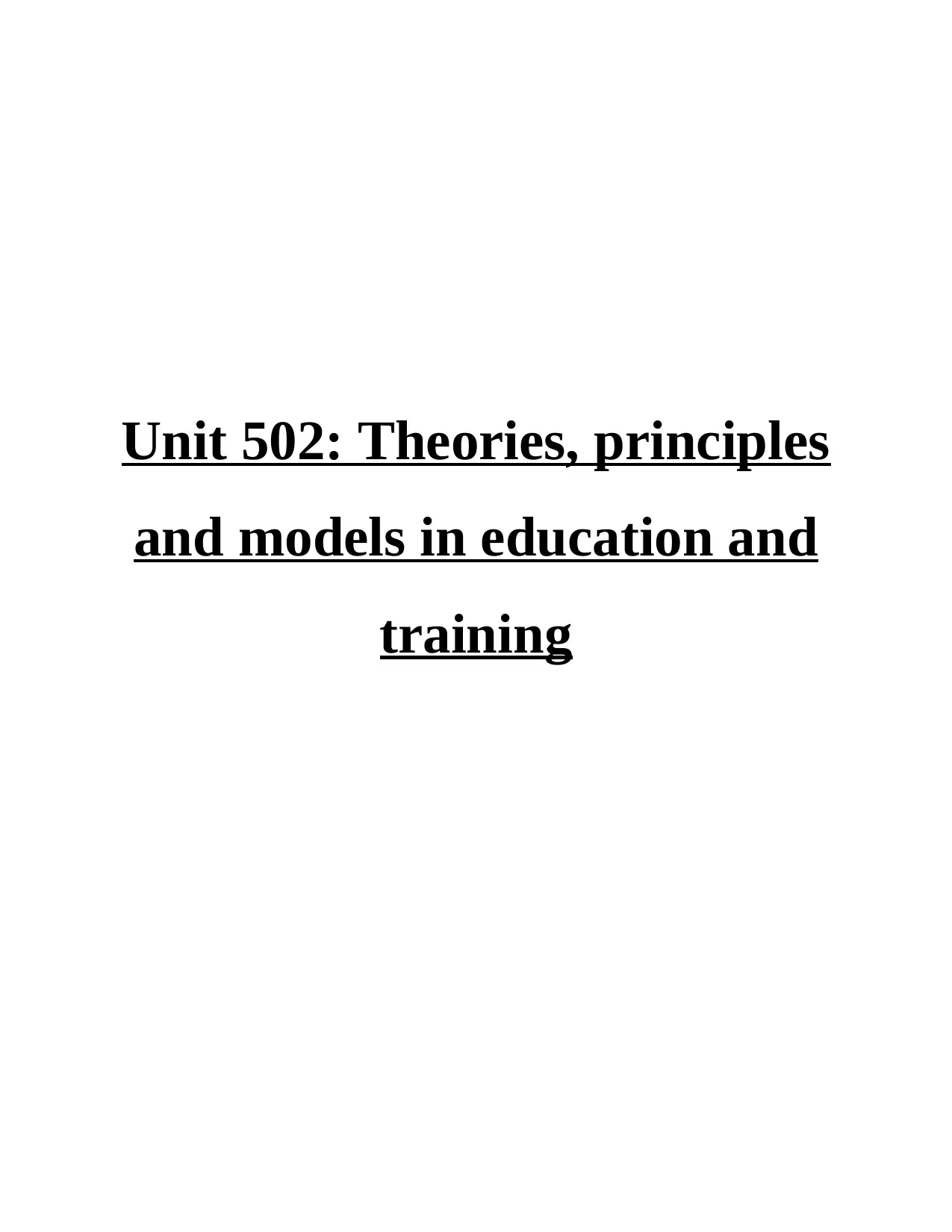
Unit 502: Theories, principles
and models in education and
training
and models in education and
training
Paraphrase This Document
Need a fresh take? Get an instant paraphrase of this document with our AI Paraphraser
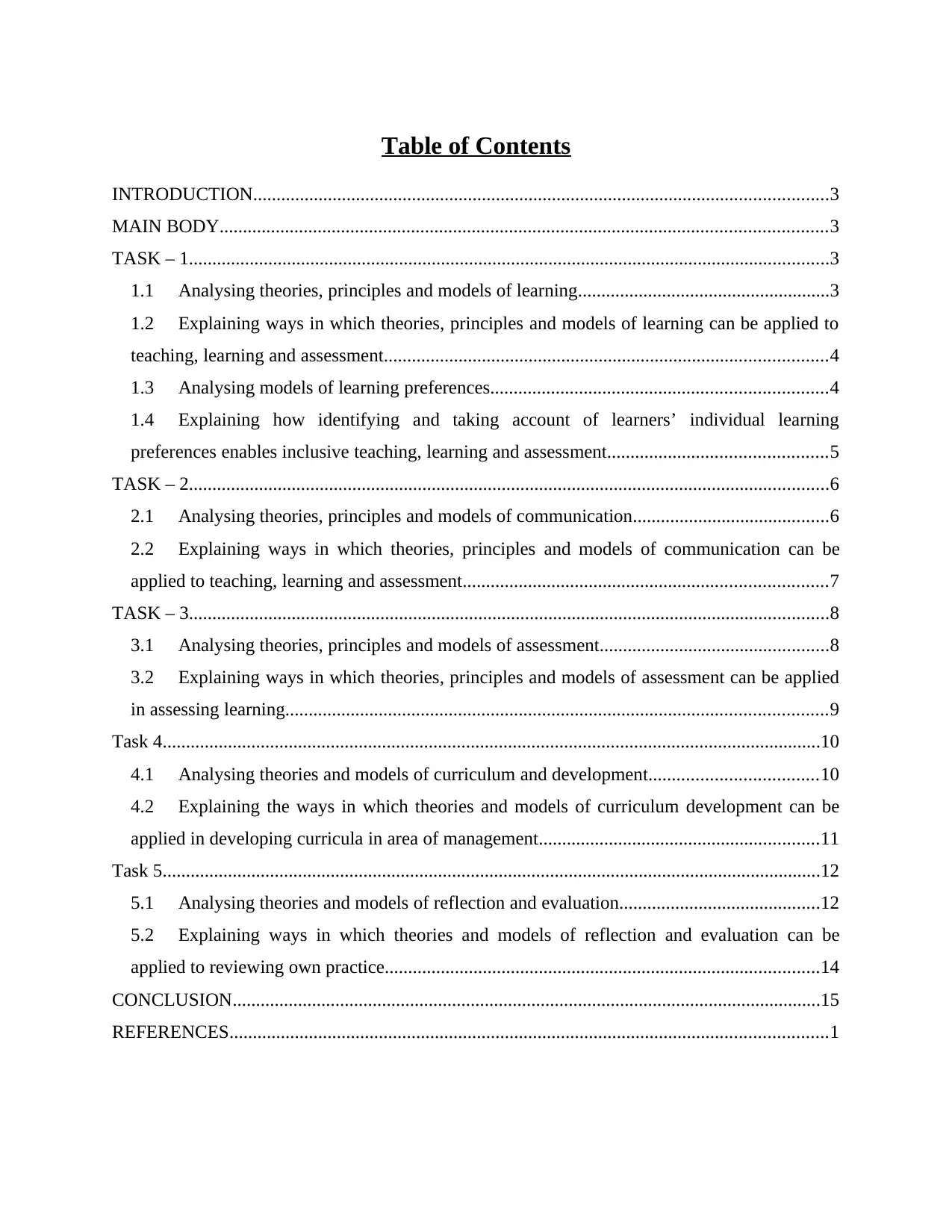
Table of Contents
INTRODUCTION...........................................................................................................................3
MAIN BODY..................................................................................................................................3
TASK – 1.........................................................................................................................................3
1.1 Analysing theories, principles and models of learning......................................................3
1.2 Explaining ways in which theories, principles and models of learning can be applied to
teaching, learning and assessment...............................................................................................4
1.3 Analysing models of learning preferences........................................................................4
1.4 Explaining how identifying and taking account of learners’ individual learning
preferences enables inclusive teaching, learning and assessment...............................................5
TASK – 2.........................................................................................................................................6
2.1 Analysing theories, principles and models of communication..........................................6
2.2 Explaining ways in which theories, principles and models of communication can be
applied to teaching, learning and assessment..............................................................................7
TASK – 3.........................................................................................................................................8
3.1 Analysing theories, principles and models of assessment.................................................8
3.2 Explaining ways in which theories, principles and models of assessment can be applied
in assessing learning....................................................................................................................9
Task 4.............................................................................................................................................10
4.1 Analysing theories and models of curriculum and development....................................10
4.2 Explaining the ways in which theories and models of curriculum development can be
applied in developing curricula in area of management............................................................11
Task 5.............................................................................................................................................12
5.1 Analysing theories and models of reflection and evaluation...........................................12
5.2 Explaining ways in which theories and models of reflection and evaluation can be
applied to reviewing own practice.............................................................................................14
CONCLUSION..............................................................................................................................15
REFERENCES................................................................................................................................1
INTRODUCTION...........................................................................................................................3
MAIN BODY..................................................................................................................................3
TASK – 1.........................................................................................................................................3
1.1 Analysing theories, principles and models of learning......................................................3
1.2 Explaining ways in which theories, principles and models of learning can be applied to
teaching, learning and assessment...............................................................................................4
1.3 Analysing models of learning preferences........................................................................4
1.4 Explaining how identifying and taking account of learners’ individual learning
preferences enables inclusive teaching, learning and assessment...............................................5
TASK – 2.........................................................................................................................................6
2.1 Analysing theories, principles and models of communication..........................................6
2.2 Explaining ways in which theories, principles and models of communication can be
applied to teaching, learning and assessment..............................................................................7
TASK – 3.........................................................................................................................................8
3.1 Analysing theories, principles and models of assessment.................................................8
3.2 Explaining ways in which theories, principles and models of assessment can be applied
in assessing learning....................................................................................................................9
Task 4.............................................................................................................................................10
4.1 Analysing theories and models of curriculum and development....................................10
4.2 Explaining the ways in which theories and models of curriculum development can be
applied in developing curricula in area of management............................................................11
Task 5.............................................................................................................................................12
5.1 Analysing theories and models of reflection and evaluation...........................................12
5.2 Explaining ways in which theories and models of reflection and evaluation can be
applied to reviewing own practice.............................................................................................14
CONCLUSION..............................................................................................................................15
REFERENCES................................................................................................................................1
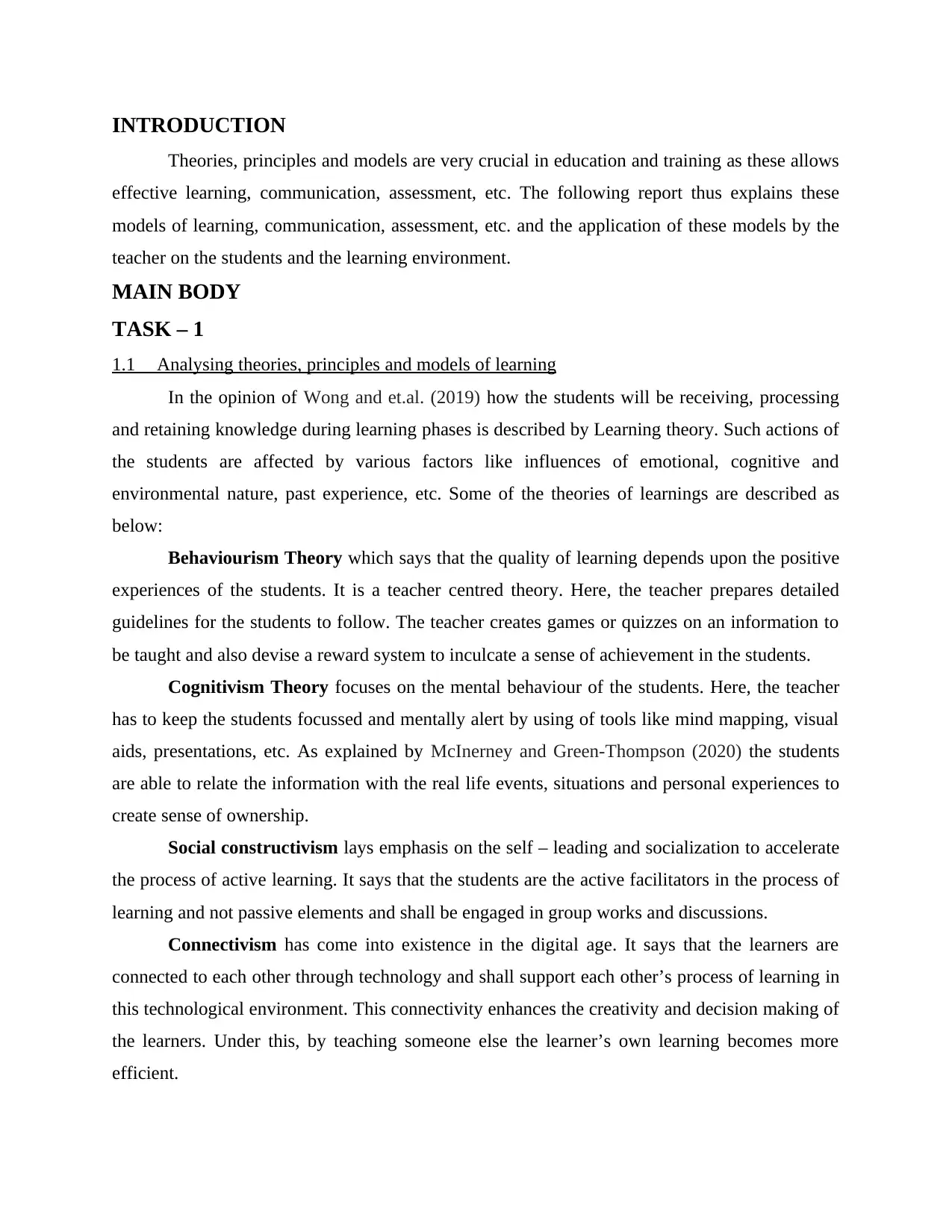
INTRODUCTION
Theories, principles and models are very crucial in education and training as these allows
effective learning, communication, assessment, etc. The following report thus explains these
models of learning, communication, assessment, etc. and the application of these models by the
teacher on the students and the learning environment.
MAIN BODY
TASK – 1
1.1 Analysing theories, principles and models of learning
In the opinion of Wong and et.al. (2019) how the students will be receiving, processing
and retaining knowledge during learning phases is described by Learning theory. Such actions of
the students are affected by various factors like influences of emotional, cognitive and
environmental nature, past experience, etc. Some of the theories of learnings are described as
below:
Behaviourism Theory which says that the quality of learning depends upon the positive
experiences of the students. It is a teacher centred theory. Here, the teacher prepares detailed
guidelines for the students to follow. The teacher creates games or quizzes on an information to
be taught and also devise a reward system to inculcate a sense of achievement in the students.
Cognitivism Theory focuses on the mental behaviour of the students. Here, the teacher
has to keep the students focussed and mentally alert by using of tools like mind mapping, visual
aids, presentations, etc. As explained by McInerney and Green-Thompson (2020) the students
are able to relate the information with the real life events, situations and personal experiences to
create sense of ownership.
Social constructivism lays emphasis on the self – leading and socialization to accelerate
the process of active learning. It says that the students are the active facilitators in the process of
learning and not passive elements and shall be engaged in group works and discussions.
Connectivism has come into existence in the digital age. It says that the learners are
connected to each other through technology and shall support each other’s process of learning in
this technological environment. This connectivity enhances the creativity and decision making of
the learners. Under this, by teaching someone else the learner’s own learning becomes more
efficient.
Theories, principles and models are very crucial in education and training as these allows
effective learning, communication, assessment, etc. The following report thus explains these
models of learning, communication, assessment, etc. and the application of these models by the
teacher on the students and the learning environment.
MAIN BODY
TASK – 1
1.1 Analysing theories, principles and models of learning
In the opinion of Wong and et.al. (2019) how the students will be receiving, processing
and retaining knowledge during learning phases is described by Learning theory. Such actions of
the students are affected by various factors like influences of emotional, cognitive and
environmental nature, past experience, etc. Some of the theories of learnings are described as
below:
Behaviourism Theory which says that the quality of learning depends upon the positive
experiences of the students. It is a teacher centred theory. Here, the teacher prepares detailed
guidelines for the students to follow. The teacher creates games or quizzes on an information to
be taught and also devise a reward system to inculcate a sense of achievement in the students.
Cognitivism Theory focuses on the mental behaviour of the students. Here, the teacher
has to keep the students focussed and mentally alert by using of tools like mind mapping, visual
aids, presentations, etc. As explained by McInerney and Green-Thompson (2020) the students
are able to relate the information with the real life events, situations and personal experiences to
create sense of ownership.
Social constructivism lays emphasis on the self – leading and socialization to accelerate
the process of active learning. It says that the students are the active facilitators in the process of
learning and not passive elements and shall be engaged in group works and discussions.
Connectivism has come into existence in the digital age. It says that the learners are
connected to each other through technology and shall support each other’s process of learning in
this technological environment. This connectivity enhances the creativity and decision making of
the learners. Under this, by teaching someone else the learner’s own learning becomes more
efficient.
⊘ This is a preview!⊘
Do you want full access?
Subscribe today to unlock all pages.

Trusted by 1+ million students worldwide
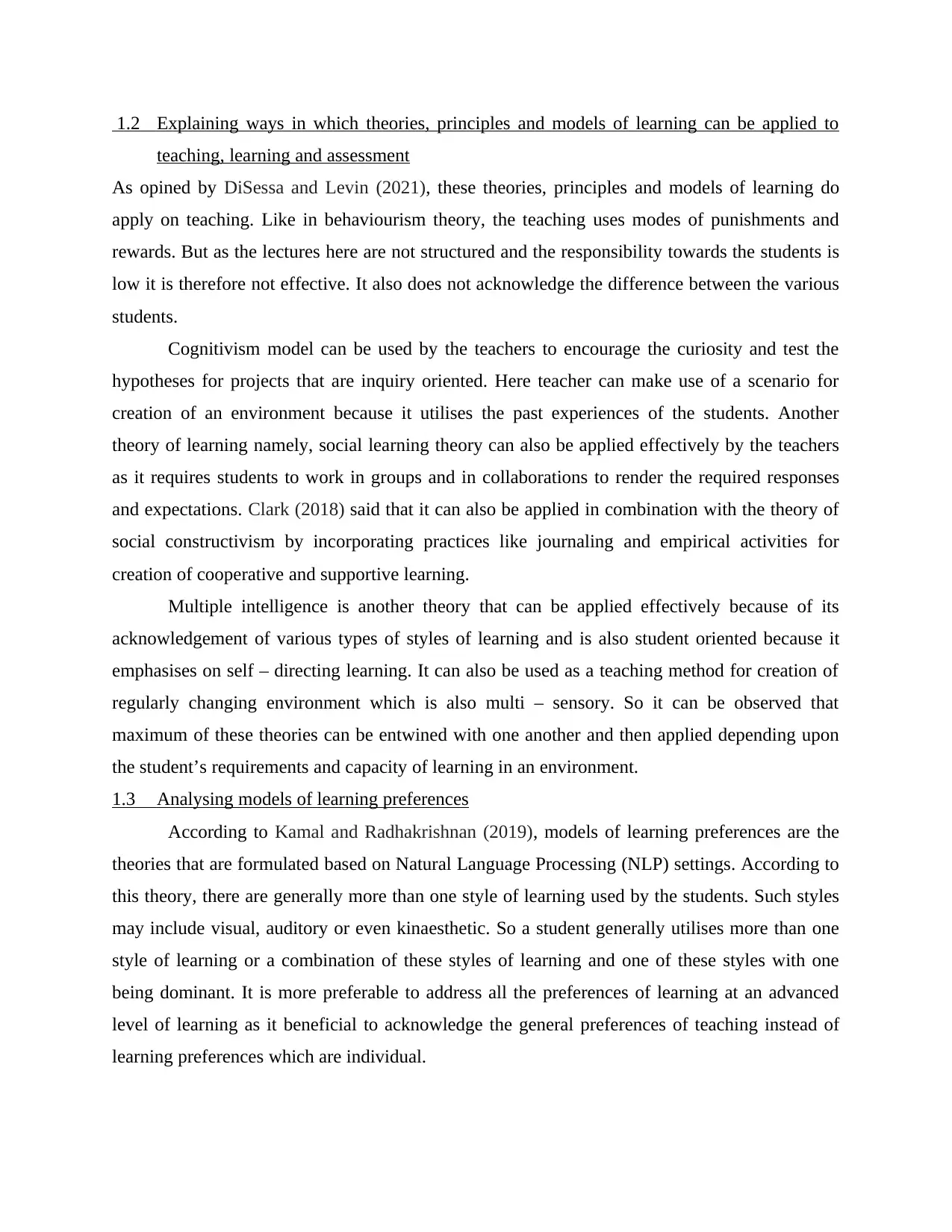
1.2 Explaining ways in which theories, principles and models of learning can be applied to
teaching, learning and assessment
As opined by DiSessa and Levin (2021), these theories, principles and models of learning do
apply on teaching. Like in behaviourism theory, the teaching uses modes of punishments and
rewards. But as the lectures here are not structured and the responsibility towards the students is
low it is therefore not effective. It also does not acknowledge the difference between the various
students.
Cognitivism model can be used by the teachers to encourage the curiosity and test the
hypotheses for projects that are inquiry oriented. Here teacher can make use of a scenario for
creation of an environment because it utilises the past experiences of the students. Another
theory of learning namely, social learning theory can also be applied effectively by the teachers
as it requires students to work in groups and in collaborations to render the required responses
and expectations. Clark (2018) said that it can also be applied in combination with the theory of
social constructivism by incorporating practices like journaling and empirical activities for
creation of cooperative and supportive learning.
Multiple intelligence is another theory that can be applied effectively because of its
acknowledgement of various types of styles of learning and is also student oriented because it
emphasises on self – directing learning. It can also be used as a teaching method for creation of
regularly changing environment which is also multi – sensory. So it can be observed that
maximum of these theories can be entwined with one another and then applied depending upon
the student’s requirements and capacity of learning in an environment.
1.3 Analysing models of learning preferences
According to Kamal and Radhakrishnan (2019), models of learning preferences are the
theories that are formulated based on Natural Language Processing (NLP) settings. According to
this theory, there are generally more than one style of learning used by the students. Such styles
may include visual, auditory or even kinaesthetic. So a student generally utilises more than one
style of learning or a combination of these styles of learning and one of these styles with one
being dominant. It is more preferable to address all the preferences of learning at an advanced
level of learning as it beneficial to acknowledge the general preferences of teaching instead of
learning preferences which are individual.
teaching, learning and assessment
As opined by DiSessa and Levin (2021), these theories, principles and models of learning do
apply on teaching. Like in behaviourism theory, the teaching uses modes of punishments and
rewards. But as the lectures here are not structured and the responsibility towards the students is
low it is therefore not effective. It also does not acknowledge the difference between the various
students.
Cognitivism model can be used by the teachers to encourage the curiosity and test the
hypotheses for projects that are inquiry oriented. Here teacher can make use of a scenario for
creation of an environment because it utilises the past experiences of the students. Another
theory of learning namely, social learning theory can also be applied effectively by the teachers
as it requires students to work in groups and in collaborations to render the required responses
and expectations. Clark (2018) said that it can also be applied in combination with the theory of
social constructivism by incorporating practices like journaling and empirical activities for
creation of cooperative and supportive learning.
Multiple intelligence is another theory that can be applied effectively because of its
acknowledgement of various types of styles of learning and is also student oriented because it
emphasises on self – directing learning. It can also be used as a teaching method for creation of
regularly changing environment which is also multi – sensory. So it can be observed that
maximum of these theories can be entwined with one another and then applied depending upon
the student’s requirements and capacity of learning in an environment.
1.3 Analysing models of learning preferences
According to Kamal and Radhakrishnan (2019), models of learning preferences are the
theories that are formulated based on Natural Language Processing (NLP) settings. According to
this theory, there are generally more than one style of learning used by the students. Such styles
may include visual, auditory or even kinaesthetic. So a student generally utilises more than one
style of learning or a combination of these styles of learning and one of these styles with one
being dominant. It is more preferable to address all the preferences of learning at an advanced
level of learning as it beneficial to acknowledge the general preferences of teaching instead of
learning preferences which are individual.
Paraphrase This Document
Need a fresh take? Get an instant paraphrase of this document with our AI Paraphraser
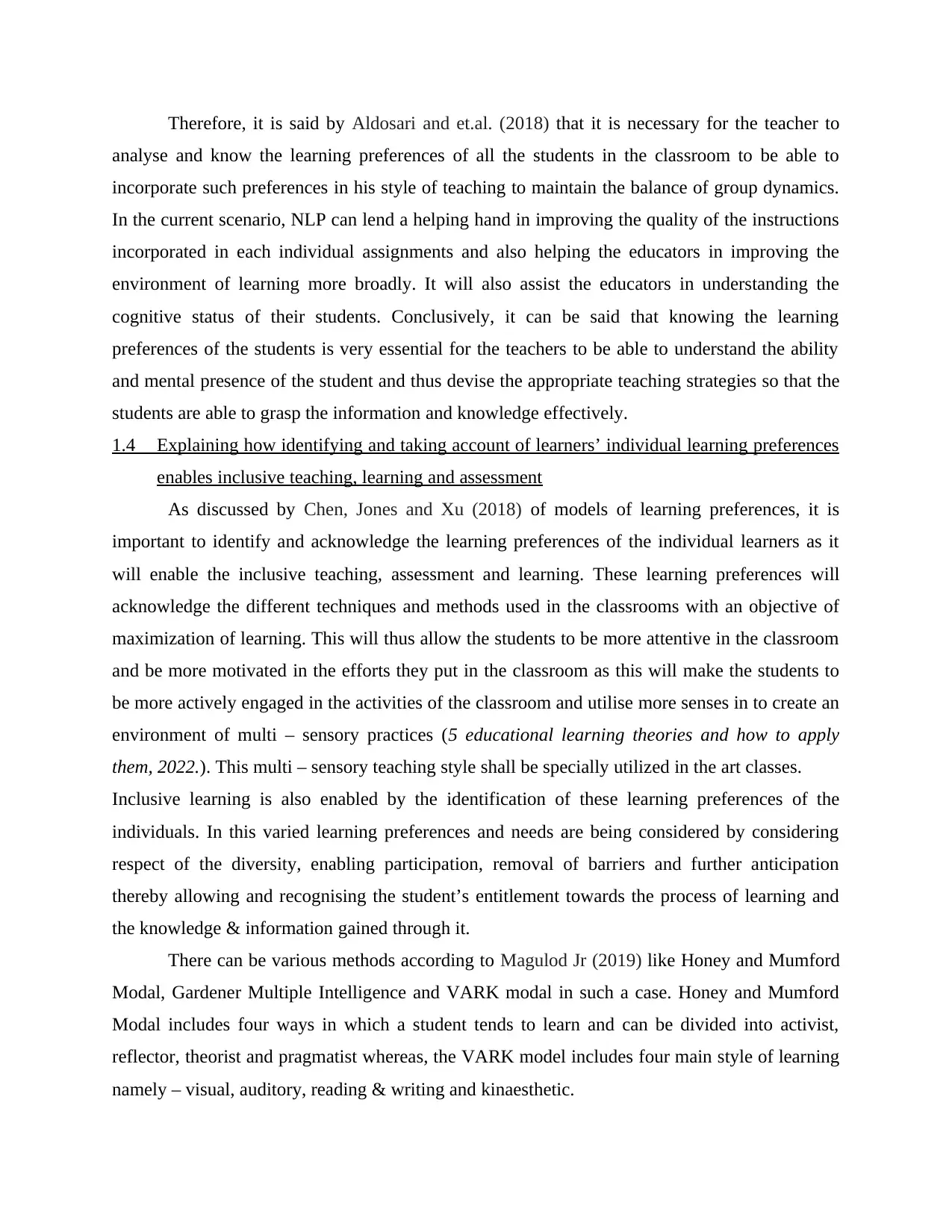
Therefore, it is said by Aldosari and et.al. (2018) that it is necessary for the teacher to
analyse and know the learning preferences of all the students in the classroom to be able to
incorporate such preferences in his style of teaching to maintain the balance of group dynamics.
In the current scenario, NLP can lend a helping hand in improving the quality of the instructions
incorporated in each individual assignments and also helping the educators in improving the
environment of learning more broadly. It will also assist the educators in understanding the
cognitive status of their students. Conclusively, it can be said that knowing the learning
preferences of the students is very essential for the teachers to be able to understand the ability
and mental presence of the student and thus devise the appropriate teaching strategies so that the
students are able to grasp the information and knowledge effectively.
1.4 Explaining how identifying and taking account of learners’ individual learning preferences
enables inclusive teaching, learning and assessment
As discussed by Chen, Jones and Xu (2018) of models of learning preferences, it is
important to identify and acknowledge the learning preferences of the individual learners as it
will enable the inclusive teaching, assessment and learning. These learning preferences will
acknowledge the different techniques and methods used in the classrooms with an objective of
maximization of learning. This will thus allow the students to be more attentive in the classroom
and be more motivated in the efforts they put in the classroom as this will make the students to
be more actively engaged in the activities of the classroom and utilise more senses in to create an
environment of multi – sensory practices (5 educational learning theories and how to apply
them, 2022.). This multi – sensory teaching style shall be specially utilized in the art classes.
Inclusive learning is also enabled by the identification of these learning preferences of the
individuals. In this varied learning preferences and needs are being considered by considering
respect of the diversity, enabling participation, removal of barriers and further anticipation
thereby allowing and recognising the student’s entitlement towards the process of learning and
the knowledge & information gained through it.
There can be various methods according to Magulod Jr (2019) like Honey and Mumford
Modal, Gardener Multiple Intelligence and VARK modal in such a case. Honey and Mumford
Modal includes four ways in which a student tends to learn and can be divided into activist,
reflector, theorist and pragmatist whereas, the VARK model includes four main style of learning
namely – visual, auditory, reading & writing and kinaesthetic.
analyse and know the learning preferences of all the students in the classroom to be able to
incorporate such preferences in his style of teaching to maintain the balance of group dynamics.
In the current scenario, NLP can lend a helping hand in improving the quality of the instructions
incorporated in each individual assignments and also helping the educators in improving the
environment of learning more broadly. It will also assist the educators in understanding the
cognitive status of their students. Conclusively, it can be said that knowing the learning
preferences of the students is very essential for the teachers to be able to understand the ability
and mental presence of the student and thus devise the appropriate teaching strategies so that the
students are able to grasp the information and knowledge effectively.
1.4 Explaining how identifying and taking account of learners’ individual learning preferences
enables inclusive teaching, learning and assessment
As discussed by Chen, Jones and Xu (2018) of models of learning preferences, it is
important to identify and acknowledge the learning preferences of the individual learners as it
will enable the inclusive teaching, assessment and learning. These learning preferences will
acknowledge the different techniques and methods used in the classrooms with an objective of
maximization of learning. This will thus allow the students to be more attentive in the classroom
and be more motivated in the efforts they put in the classroom as this will make the students to
be more actively engaged in the activities of the classroom and utilise more senses in to create an
environment of multi – sensory practices (5 educational learning theories and how to apply
them, 2022.). This multi – sensory teaching style shall be specially utilized in the art classes.
Inclusive learning is also enabled by the identification of these learning preferences of the
individuals. In this varied learning preferences and needs are being considered by considering
respect of the diversity, enabling participation, removal of barriers and further anticipation
thereby allowing and recognising the student’s entitlement towards the process of learning and
the knowledge & information gained through it.
There can be various methods according to Magulod Jr (2019) like Honey and Mumford
Modal, Gardener Multiple Intelligence and VARK modal in such a case. Honey and Mumford
Modal includes four ways in which a student tends to learn and can be divided into activist,
reflector, theorist and pragmatist whereas, the VARK model includes four main style of learning
namely – visual, auditory, reading & writing and kinaesthetic.
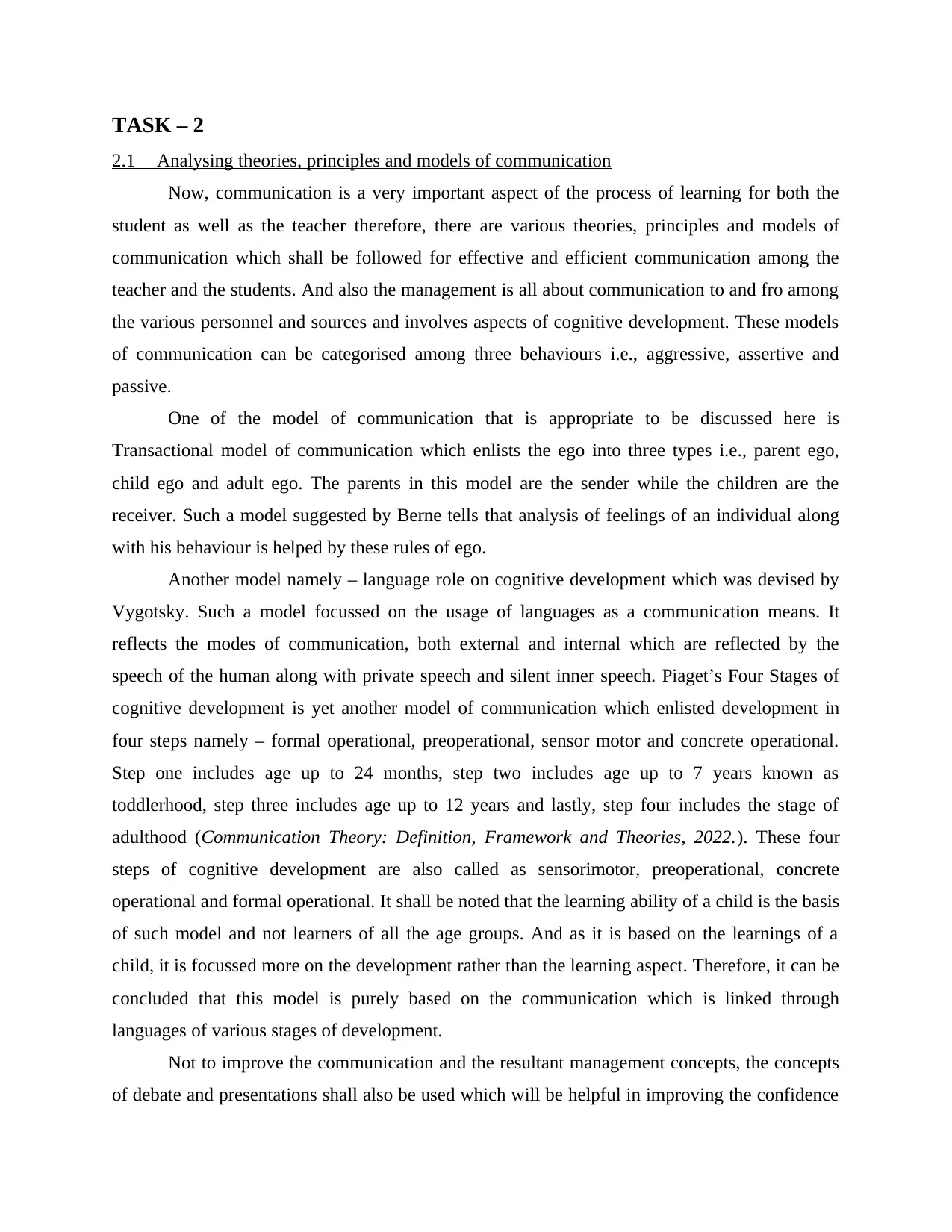
TASK – 2
2.1 Analysing theories, principles and models of communication
Now, communication is a very important aspect of the process of learning for both the
student as well as the teacher therefore, there are various theories, principles and models of
communication which shall be followed for effective and efficient communication among the
teacher and the students. And also the management is all about communication to and fro among
the various personnel and sources and involves aspects of cognitive development. These models
of communication can be categorised among three behaviours i.e., aggressive, assertive and
passive.
One of the model of communication that is appropriate to be discussed here is
Transactional model of communication which enlists the ego into three types i.e., parent ego,
child ego and adult ego. The parents in this model are the sender while the children are the
receiver. Such a model suggested by Berne tells that analysis of feelings of an individual along
with his behaviour is helped by these rules of ego.
Another model namely – language role on cognitive development which was devised by
Vygotsky. Such a model focussed on the usage of languages as a communication means. It
reflects the modes of communication, both external and internal which are reflected by the
speech of the human along with private speech and silent inner speech. Piaget’s Four Stages of
cognitive development is yet another model of communication which enlisted development in
four steps namely – formal operational, preoperational, sensor motor and concrete operational.
Step one includes age up to 24 months, step two includes age up to 7 years known as
toddlerhood, step three includes age up to 12 years and lastly, step four includes the stage of
adulthood (Communication Theory: Definition, Framework and Theories, 2022.). These four
steps of cognitive development are also called as sensorimotor, preoperational, concrete
operational and formal operational. It shall be noted that the learning ability of a child is the basis
of such model and not learners of all the age groups. And as it is based on the learnings of a
child, it is focussed more on the development rather than the learning aspect. Therefore, it can be
concluded that this model is purely based on the communication which is linked through
languages of various stages of development.
Not to improve the communication and the resultant management concepts, the concepts
of debate and presentations shall also be used which will be helpful in improving the confidence
2.1 Analysing theories, principles and models of communication
Now, communication is a very important aspect of the process of learning for both the
student as well as the teacher therefore, there are various theories, principles and models of
communication which shall be followed for effective and efficient communication among the
teacher and the students. And also the management is all about communication to and fro among
the various personnel and sources and involves aspects of cognitive development. These models
of communication can be categorised among three behaviours i.e., aggressive, assertive and
passive.
One of the model of communication that is appropriate to be discussed here is
Transactional model of communication which enlists the ego into three types i.e., parent ego,
child ego and adult ego. The parents in this model are the sender while the children are the
receiver. Such a model suggested by Berne tells that analysis of feelings of an individual along
with his behaviour is helped by these rules of ego.
Another model namely – language role on cognitive development which was devised by
Vygotsky. Such a model focussed on the usage of languages as a communication means. It
reflects the modes of communication, both external and internal which are reflected by the
speech of the human along with private speech and silent inner speech. Piaget’s Four Stages of
cognitive development is yet another model of communication which enlisted development in
four steps namely – formal operational, preoperational, sensor motor and concrete operational.
Step one includes age up to 24 months, step two includes age up to 7 years known as
toddlerhood, step three includes age up to 12 years and lastly, step four includes the stage of
adulthood (Communication Theory: Definition, Framework and Theories, 2022.). These four
steps of cognitive development are also called as sensorimotor, preoperational, concrete
operational and formal operational. It shall be noted that the learning ability of a child is the basis
of such model and not learners of all the age groups. And as it is based on the learnings of a
child, it is focussed more on the development rather than the learning aspect. Therefore, it can be
concluded that this model is purely based on the communication which is linked through
languages of various stages of development.
Not to improve the communication and the resultant management concepts, the concepts
of debate and presentations shall also be used which will be helpful in improving the confidence
⊘ This is a preview!⊘
Do you want full access?
Subscribe today to unlock all pages.

Trusted by 1+ million students worldwide
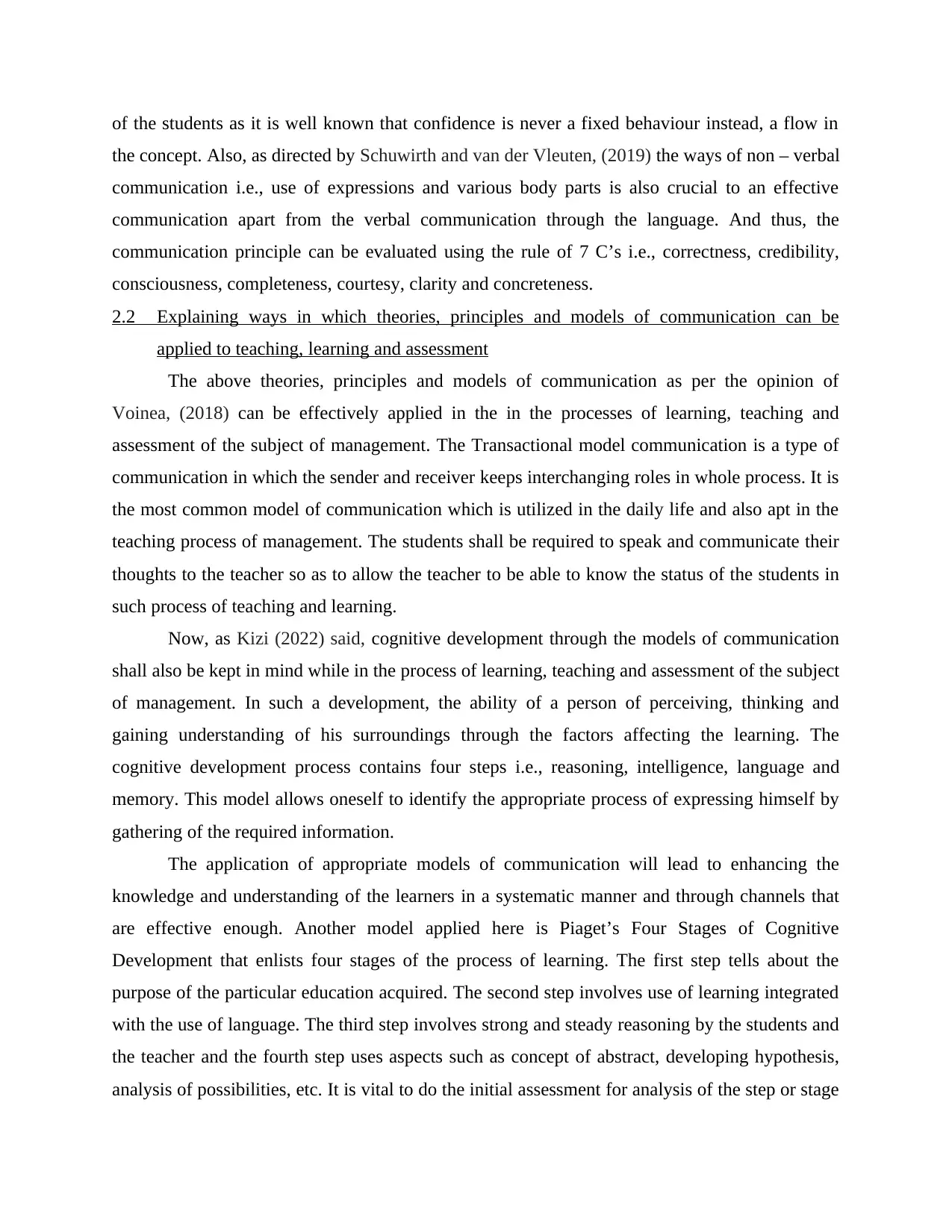
of the students as it is well known that confidence is never a fixed behaviour instead, a flow in
the concept. Also, as directed by Schuwirth and van der Vleuten, (2019) the ways of non – verbal
communication i.e., use of expressions and various body parts is also crucial to an effective
communication apart from the verbal communication through the language. And thus, the
communication principle can be evaluated using the rule of 7 C’s i.e., correctness, credibility,
consciousness, completeness, courtesy, clarity and concreteness.
2.2 Explaining ways in which theories, principles and models of communication can be
applied to teaching, learning and assessment
The above theories, principles and models of communication as per the opinion of
Voinea, (2018) can be effectively applied in the in the processes of learning, teaching and
assessment of the subject of management. The Transactional model communication is a type of
communication in which the sender and receiver keeps interchanging roles in whole process. It is
the most common model of communication which is utilized in the daily life and also apt in the
teaching process of management. The students shall be required to speak and communicate their
thoughts to the teacher so as to allow the teacher to be able to know the status of the students in
such process of teaching and learning.
Now, as Kizi (2022) said, cognitive development through the models of communication
shall also be kept in mind while in the process of learning, teaching and assessment of the subject
of management. In such a development, the ability of a person of perceiving, thinking and
gaining understanding of his surroundings through the factors affecting the learning. The
cognitive development process contains four steps i.e., reasoning, intelligence, language and
memory. This model allows oneself to identify the appropriate process of expressing himself by
gathering of the required information.
The application of appropriate models of communication will lead to enhancing the
knowledge and understanding of the learners in a systematic manner and through channels that
are effective enough. Another model applied here is Piaget’s Four Stages of Cognitive
Development that enlists four stages of the process of learning. The first step tells about the
purpose of the particular education acquired. The second step involves use of learning integrated
with the use of language. The third step involves strong and steady reasoning by the students and
the teacher and the fourth step uses aspects such as concept of abstract, developing hypothesis,
analysis of possibilities, etc. It is vital to do the initial assessment for analysis of the step or stage
the concept. Also, as directed by Schuwirth and van der Vleuten, (2019) the ways of non – verbal
communication i.e., use of expressions and various body parts is also crucial to an effective
communication apart from the verbal communication through the language. And thus, the
communication principle can be evaluated using the rule of 7 C’s i.e., correctness, credibility,
consciousness, completeness, courtesy, clarity and concreteness.
2.2 Explaining ways in which theories, principles and models of communication can be
applied to teaching, learning and assessment
The above theories, principles and models of communication as per the opinion of
Voinea, (2018) can be effectively applied in the in the processes of learning, teaching and
assessment of the subject of management. The Transactional model communication is a type of
communication in which the sender and receiver keeps interchanging roles in whole process. It is
the most common model of communication which is utilized in the daily life and also apt in the
teaching process of management. The students shall be required to speak and communicate their
thoughts to the teacher so as to allow the teacher to be able to know the status of the students in
such process of teaching and learning.
Now, as Kizi (2022) said, cognitive development through the models of communication
shall also be kept in mind while in the process of learning, teaching and assessment of the subject
of management. In such a development, the ability of a person of perceiving, thinking and
gaining understanding of his surroundings through the factors affecting the learning. The
cognitive development process contains four steps i.e., reasoning, intelligence, language and
memory. This model allows oneself to identify the appropriate process of expressing himself by
gathering of the required information.
The application of appropriate models of communication will lead to enhancing the
knowledge and understanding of the learners in a systematic manner and through channels that
are effective enough. Another model applied here is Piaget’s Four Stages of Cognitive
Development that enlists four stages of the process of learning. The first step tells about the
purpose of the particular education acquired. The second step involves use of learning integrated
with the use of language. The third step involves strong and steady reasoning by the students and
the teacher and the fourth step uses aspects such as concept of abstract, developing hypothesis,
analysis of possibilities, etc. It is vital to do the initial assessment for analysis of the step or stage
Paraphrase This Document
Need a fresh take? Get an instant paraphrase of this document with our AI Paraphraser
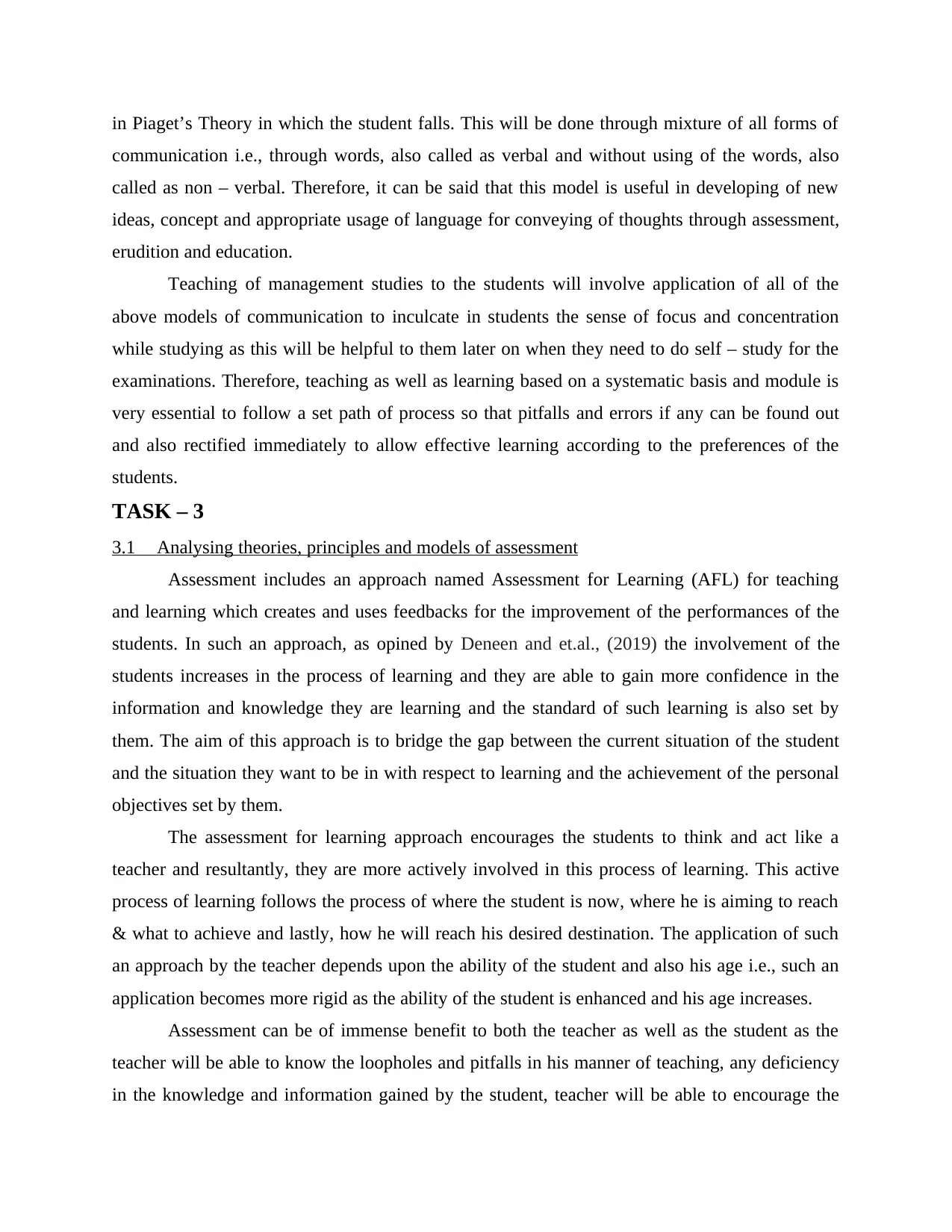
in Piaget’s Theory in which the student falls. This will be done through mixture of all forms of
communication i.e., through words, also called as verbal and without using of the words, also
called as non – verbal. Therefore, it can be said that this model is useful in developing of new
ideas, concept and appropriate usage of language for conveying of thoughts through assessment,
erudition and education.
Teaching of management studies to the students will involve application of all of the
above models of communication to inculcate in students the sense of focus and concentration
while studying as this will be helpful to them later on when they need to do self – study for the
examinations. Therefore, teaching as well as learning based on a systematic basis and module is
very essential to follow a set path of process so that pitfalls and errors if any can be found out
and also rectified immediately to allow effective learning according to the preferences of the
students.
TASK – 3
3.1 Analysing theories, principles and models of assessment
Assessment includes an approach named Assessment for Learning (AFL) for teaching
and learning which creates and uses feedbacks for the improvement of the performances of the
students. In such an approach, as opined by Deneen and et.al., (2019) the involvement of the
students increases in the process of learning and they are able to gain more confidence in the
information and knowledge they are learning and the standard of such learning is also set by
them. The aim of this approach is to bridge the gap between the current situation of the student
and the situation they want to be in with respect to learning and the achievement of the personal
objectives set by them.
The assessment for learning approach encourages the students to think and act like a
teacher and resultantly, they are more actively involved in this process of learning. This active
process of learning follows the process of where the student is now, where he is aiming to reach
& what to achieve and lastly, how he will reach his desired destination. The application of such
an approach by the teacher depends upon the ability of the student and also his age i.e., such an
application becomes more rigid as the ability of the student is enhanced and his age increases.
Assessment can be of immense benefit to both the teacher as well as the student as the
teacher will be able to know the loopholes and pitfalls in his manner of teaching, any deficiency
in the knowledge and information gained by the student, teacher will be able to encourage the
communication i.e., through words, also called as verbal and without using of the words, also
called as non – verbal. Therefore, it can be said that this model is useful in developing of new
ideas, concept and appropriate usage of language for conveying of thoughts through assessment,
erudition and education.
Teaching of management studies to the students will involve application of all of the
above models of communication to inculcate in students the sense of focus and concentration
while studying as this will be helpful to them later on when they need to do self – study for the
examinations. Therefore, teaching as well as learning based on a systematic basis and module is
very essential to follow a set path of process so that pitfalls and errors if any can be found out
and also rectified immediately to allow effective learning according to the preferences of the
students.
TASK – 3
3.1 Analysing theories, principles and models of assessment
Assessment includes an approach named Assessment for Learning (AFL) for teaching
and learning which creates and uses feedbacks for the improvement of the performances of the
students. In such an approach, as opined by Deneen and et.al., (2019) the involvement of the
students increases in the process of learning and they are able to gain more confidence in the
information and knowledge they are learning and the standard of such learning is also set by
them. The aim of this approach is to bridge the gap between the current situation of the student
and the situation they want to be in with respect to learning and the achievement of the personal
objectives set by them.
The assessment for learning approach encourages the students to think and act like a
teacher and resultantly, they are more actively involved in this process of learning. This active
process of learning follows the process of where the student is now, where he is aiming to reach
& what to achieve and lastly, how he will reach his desired destination. The application of such
an approach by the teacher depends upon the ability of the student and also his age i.e., such an
application becomes more rigid as the ability of the student is enhanced and his age increases.
Assessment can be of immense benefit to both the teacher as well as the student as the
teacher will be able to know the loopholes and pitfalls in his manner of teaching, any deficiency
in the knowledge and information gained by the student, teacher will be able to encourage the
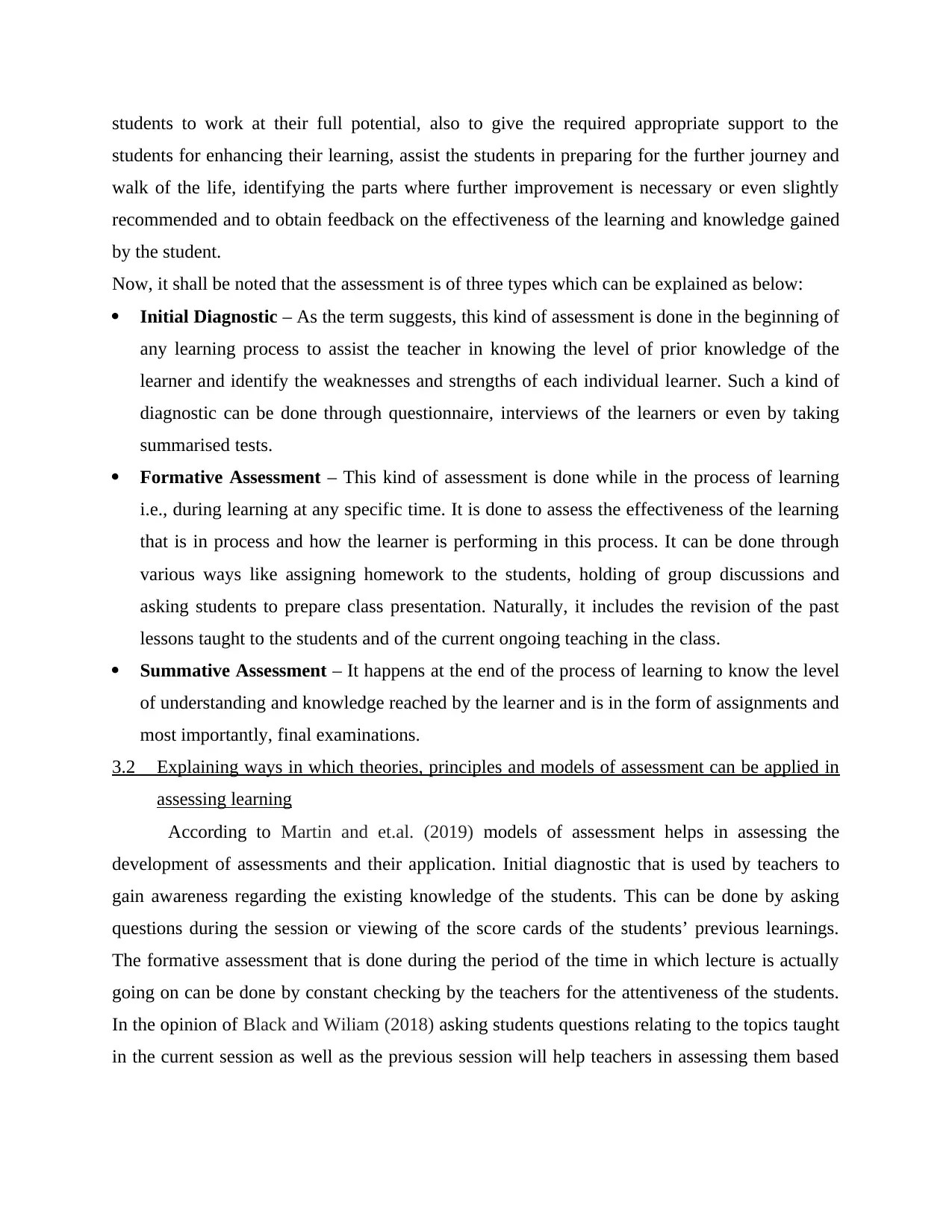
students to work at their full potential, also to give the required appropriate support to the
students for enhancing their learning, assist the students in preparing for the further journey and
walk of the life, identifying the parts where further improvement is necessary or even slightly
recommended and to obtain feedback on the effectiveness of the learning and knowledge gained
by the student.
Now, it shall be noted that the assessment is of three types which can be explained as below:
Initial Diagnostic – As the term suggests, this kind of assessment is done in the beginning of
any learning process to assist the teacher in knowing the level of prior knowledge of the
learner and identify the weaknesses and strengths of each individual learner. Such a kind of
diagnostic can be done through questionnaire, interviews of the learners or even by taking
summarised tests.
Formative Assessment – This kind of assessment is done while in the process of learning
i.e., during learning at any specific time. It is done to assess the effectiveness of the learning
that is in process and how the learner is performing in this process. It can be done through
various ways like assigning homework to the students, holding of group discussions and
asking students to prepare class presentation. Naturally, it includes the revision of the past
lessons taught to the students and of the current ongoing teaching in the class.
Summative Assessment – It happens at the end of the process of learning to know the level
of understanding and knowledge reached by the learner and is in the form of assignments and
most importantly, final examinations.
3.2 Explaining ways in which theories, principles and models of assessment can be applied in
assessing learning
According to Martin and et.al. (2019) models of assessment helps in assessing the
development of assessments and their application. Initial diagnostic that is used by teachers to
gain awareness regarding the existing knowledge of the students. This can be done by asking
questions during the session or viewing of the score cards of the students’ previous learnings.
The formative assessment that is done during the period of the time in which lecture is actually
going on can be done by constant checking by the teachers for the attentiveness of the students.
In the opinion of Black and Wiliam (2018) asking students questions relating to the topics taught
in the current session as well as the previous session will help teachers in assessing them based
students for enhancing their learning, assist the students in preparing for the further journey and
walk of the life, identifying the parts where further improvement is necessary or even slightly
recommended and to obtain feedback on the effectiveness of the learning and knowledge gained
by the student.
Now, it shall be noted that the assessment is of three types which can be explained as below:
Initial Diagnostic – As the term suggests, this kind of assessment is done in the beginning of
any learning process to assist the teacher in knowing the level of prior knowledge of the
learner and identify the weaknesses and strengths of each individual learner. Such a kind of
diagnostic can be done through questionnaire, interviews of the learners or even by taking
summarised tests.
Formative Assessment – This kind of assessment is done while in the process of learning
i.e., during learning at any specific time. It is done to assess the effectiveness of the learning
that is in process and how the learner is performing in this process. It can be done through
various ways like assigning homework to the students, holding of group discussions and
asking students to prepare class presentation. Naturally, it includes the revision of the past
lessons taught to the students and of the current ongoing teaching in the class.
Summative Assessment – It happens at the end of the process of learning to know the level
of understanding and knowledge reached by the learner and is in the form of assignments and
most importantly, final examinations.
3.2 Explaining ways in which theories, principles and models of assessment can be applied in
assessing learning
According to Martin and et.al. (2019) models of assessment helps in assessing the
development of assessments and their application. Initial diagnostic that is used by teachers to
gain awareness regarding the existing knowledge of the students. This can be done by asking
questions during the session or viewing of the score cards of the students’ previous learnings.
The formative assessment that is done during the period of the time in which lecture is actually
going on can be done by constant checking by the teachers for the attentiveness of the students.
In the opinion of Black and Wiliam (2018) asking students questions relating to the topics taught
in the current session as well as the previous session will help teachers in assessing them based
⊘ This is a preview!⊘
Do you want full access?
Subscribe today to unlock all pages.

Trusted by 1+ million students worldwide
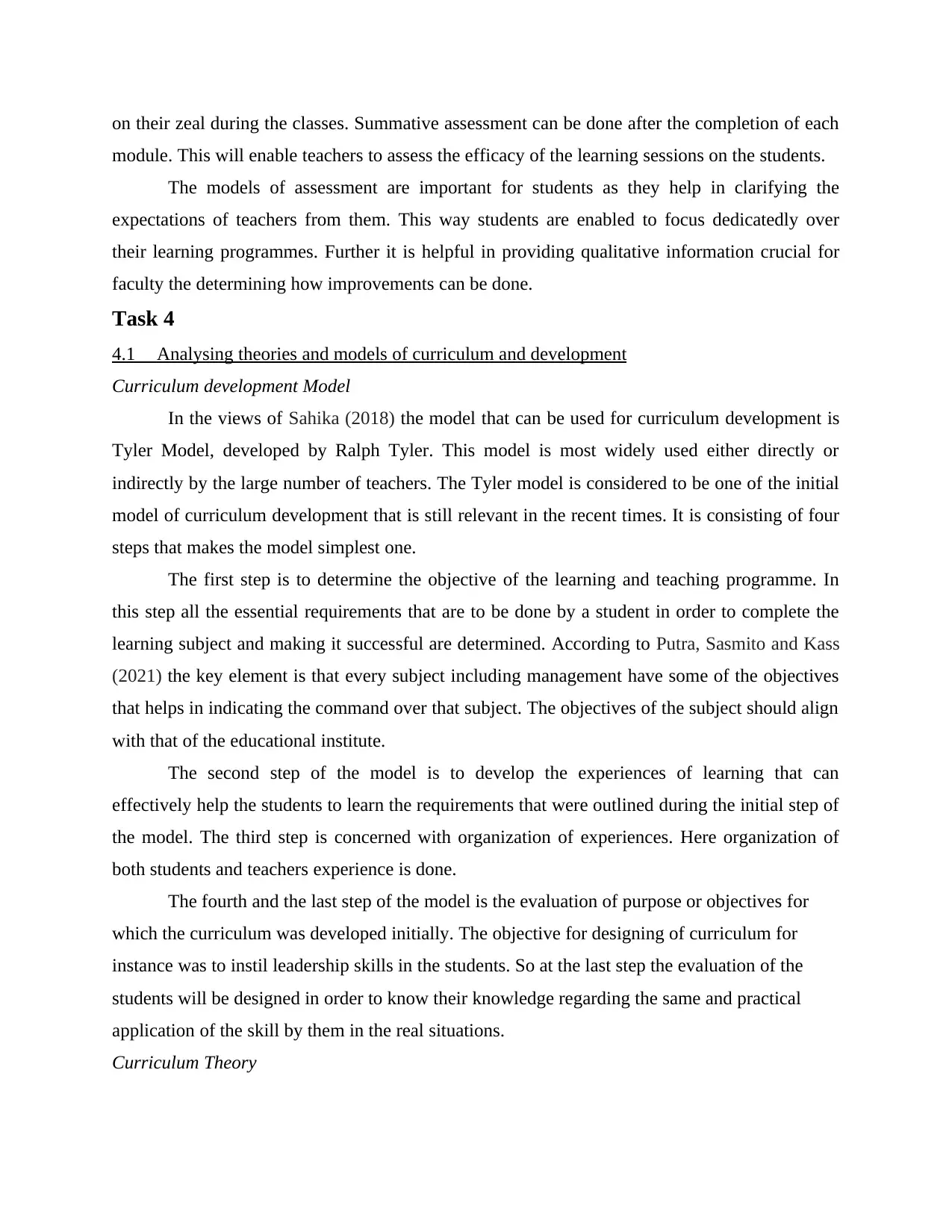
on their zeal during the classes. Summative assessment can be done after the completion of each
module. This will enable teachers to assess the efficacy of the learning sessions on the students.
The models of assessment are important for students as they help in clarifying the
expectations of teachers from them. This way students are enabled to focus dedicatedly over
their learning programmes. Further it is helpful in providing qualitative information crucial for
faculty the determining how improvements can be done.
Task 4
4.1 Analysing theories and models of curriculum and development
Curriculum development Model
In the views of Sahika (2018) the model that can be used for curriculum development is
Tyler Model, developed by Ralph Tyler. This model is most widely used either directly or
indirectly by the large number of teachers. The Tyler model is considered to be one of the initial
model of curriculum development that is still relevant in the recent times. It is consisting of four
steps that makes the model simplest one.
The first step is to determine the objective of the learning and teaching programme. In
this step all the essential requirements that are to be done by a student in order to complete the
learning subject and making it successful are determined. According to Putra, Sasmito and Kass
(2021) the key element is that every subject including management have some of the objectives
that helps in indicating the command over that subject. The objectives of the subject should align
with that of the educational institute.
The second step of the model is to develop the experiences of learning that can
effectively help the students to learn the requirements that were outlined during the initial step of
the model. The third step is concerned with organization of experiences. Here organization of
both students and teachers experience is done.
The fourth and the last step of the model is the evaluation of purpose or objectives for
which the curriculum was developed initially. The objective for designing of curriculum for
instance was to instil leadership skills in the students. So at the last step the evaluation of the
students will be designed in order to know their knowledge regarding the same and practical
application of the skill by them in the real situations.
Curriculum Theory
module. This will enable teachers to assess the efficacy of the learning sessions on the students.
The models of assessment are important for students as they help in clarifying the
expectations of teachers from them. This way students are enabled to focus dedicatedly over
their learning programmes. Further it is helpful in providing qualitative information crucial for
faculty the determining how improvements can be done.
Task 4
4.1 Analysing theories and models of curriculum and development
Curriculum development Model
In the views of Sahika (2018) the model that can be used for curriculum development is
Tyler Model, developed by Ralph Tyler. This model is most widely used either directly or
indirectly by the large number of teachers. The Tyler model is considered to be one of the initial
model of curriculum development that is still relevant in the recent times. It is consisting of four
steps that makes the model simplest one.
The first step is to determine the objective of the learning and teaching programme. In
this step all the essential requirements that are to be done by a student in order to complete the
learning subject and making it successful are determined. According to Putra, Sasmito and Kass
(2021) the key element is that every subject including management have some of the objectives
that helps in indicating the command over that subject. The objectives of the subject should align
with that of the educational institute.
The second step of the model is to develop the experiences of learning that can
effectively help the students to learn the requirements that were outlined during the initial step of
the model. The third step is concerned with organization of experiences. Here organization of
both students and teachers experience is done.
The fourth and the last step of the model is the evaluation of purpose or objectives for
which the curriculum was developed initially. The objective for designing of curriculum for
instance was to instil leadership skills in the students. So at the last step the evaluation of the
students will be designed in order to know their knowledge regarding the same and practical
application of the skill by them in the real situations.
Curriculum Theory
Paraphrase This Document
Need a fresh take? Get an instant paraphrase of this document with our AI Paraphraser
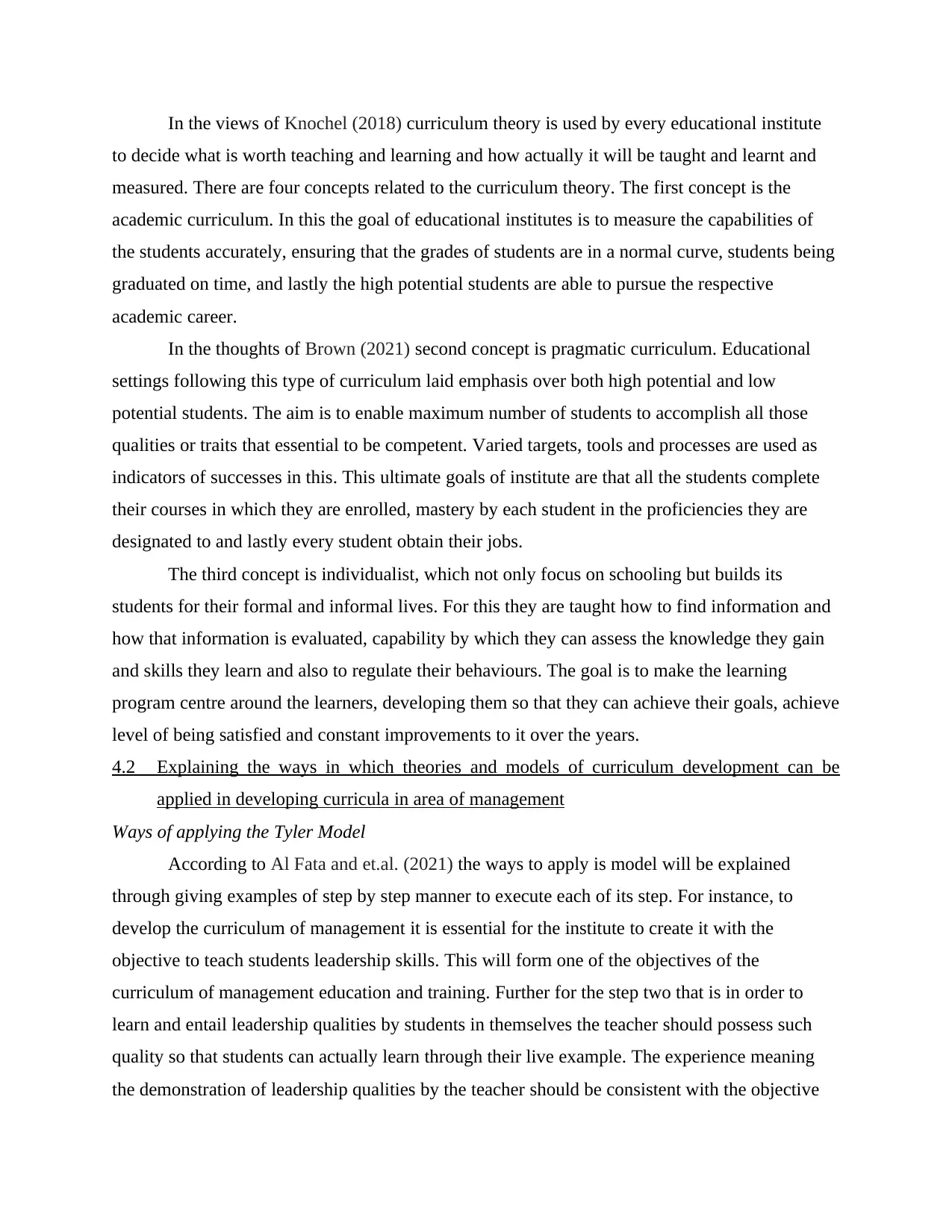
In the views of Knochel (2018) curriculum theory is used by every educational institute
to decide what is worth teaching and learning and how actually it will be taught and learnt and
measured. There are four concepts related to the curriculum theory. The first concept is the
academic curriculum. In this the goal of educational institutes is to measure the capabilities of
the students accurately, ensuring that the grades of students are in a normal curve, students being
graduated on time, and lastly the high potential students are able to pursue the respective
academic career.
In the thoughts of Brown (2021) second concept is pragmatic curriculum. Educational
settings following this type of curriculum laid emphasis over both high potential and low
potential students. The aim is to enable maximum number of students to accomplish all those
qualities or traits that essential to be competent. Varied targets, tools and processes are used as
indicators of successes in this. This ultimate goals of institute are that all the students complete
their courses in which they are enrolled, mastery by each student in the proficiencies they are
designated to and lastly every student obtain their jobs.
The third concept is individualist, which not only focus on schooling but builds its
students for their formal and informal lives. For this they are taught how to find information and
how that information is evaluated, capability by which they can assess the knowledge they gain
and skills they learn and also to regulate their behaviours. The goal is to make the learning
program centre around the learners, developing them so that they can achieve their goals, achieve
level of being satisfied and constant improvements to it over the years.
4.2 Explaining the ways in which theories and models of curriculum development can be
applied in developing curricula in area of management
Ways of applying the Tyler Model
According to Al Fata and et.al. (2021) the ways to apply is model will be explained
through giving examples of step by step manner to execute each of its step. For instance, to
develop the curriculum of management it is essential for the institute to create it with the
objective to teach students leadership skills. This will form one of the objectives of the
curriculum of management education and training. Further for the step two that is in order to
learn and entail leadership qualities by students in themselves the teacher should possess such
quality so that students can actually learn through their live example. The experience meaning
the demonstration of leadership qualities by the teacher should be consistent with the objective
to decide what is worth teaching and learning and how actually it will be taught and learnt and
measured. There are four concepts related to the curriculum theory. The first concept is the
academic curriculum. In this the goal of educational institutes is to measure the capabilities of
the students accurately, ensuring that the grades of students are in a normal curve, students being
graduated on time, and lastly the high potential students are able to pursue the respective
academic career.
In the thoughts of Brown (2021) second concept is pragmatic curriculum. Educational
settings following this type of curriculum laid emphasis over both high potential and low
potential students. The aim is to enable maximum number of students to accomplish all those
qualities or traits that essential to be competent. Varied targets, tools and processes are used as
indicators of successes in this. This ultimate goals of institute are that all the students complete
their courses in which they are enrolled, mastery by each student in the proficiencies they are
designated to and lastly every student obtain their jobs.
The third concept is individualist, which not only focus on schooling but builds its
students for their formal and informal lives. For this they are taught how to find information and
how that information is evaluated, capability by which they can assess the knowledge they gain
and skills they learn and also to regulate their behaviours. The goal is to make the learning
program centre around the learners, developing them so that they can achieve their goals, achieve
level of being satisfied and constant improvements to it over the years.
4.2 Explaining the ways in which theories and models of curriculum development can be
applied in developing curricula in area of management
Ways of applying the Tyler Model
According to Al Fata and et.al. (2021) the ways to apply is model will be explained
through giving examples of step by step manner to execute each of its step. For instance, to
develop the curriculum of management it is essential for the institute to create it with the
objective to teach students leadership skills. This will form one of the objectives of the
curriculum of management education and training. Further for the step two that is in order to
learn and entail leadership qualities by students in themselves the teacher should possess such
quality so that students can actually learn through their live example. The experience meaning
the demonstration of leadership qualities by the teacher should be consistent with the objective
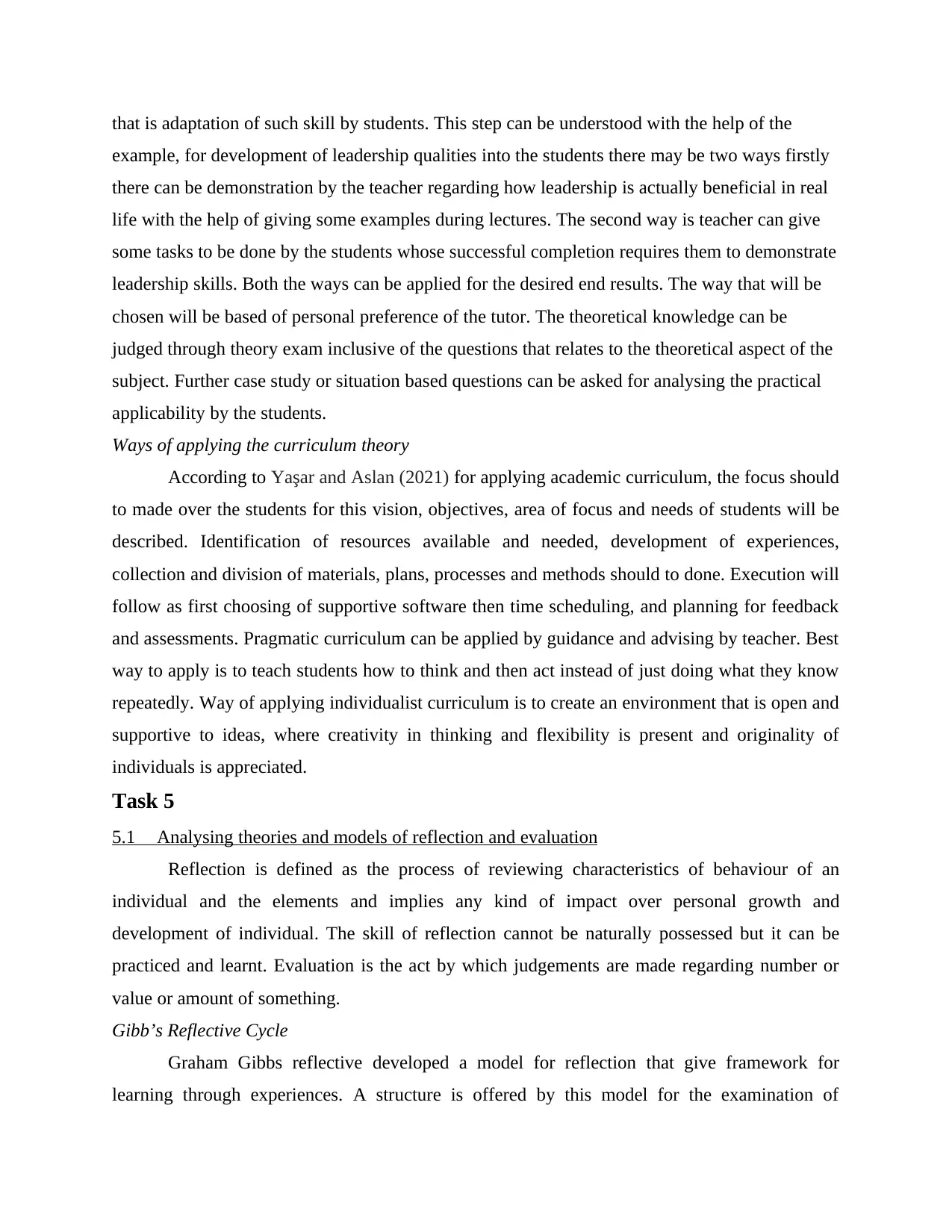
that is adaptation of such skill by students. This step can be understood with the help of the
example, for development of leadership qualities into the students there may be two ways firstly
there can be demonstration by the teacher regarding how leadership is actually beneficial in real
life with the help of giving some examples during lectures. The second way is teacher can give
some tasks to be done by the students whose successful completion requires them to demonstrate
leadership skills. Both the ways can be applied for the desired end results. The way that will be
chosen will be based of personal preference of the tutor. The theoretical knowledge can be
judged through theory exam inclusive of the questions that relates to the theoretical aspect of the
subject. Further case study or situation based questions can be asked for analysing the practical
applicability by the students.
Ways of applying the curriculum theory
According to Yaşar and Aslan (2021) for applying academic curriculum, the focus should
to made over the students for this vision, objectives, area of focus and needs of students will be
described. Identification of resources available and needed, development of experiences,
collection and division of materials, plans, processes and methods should to done. Execution will
follow as first choosing of supportive software then time scheduling, and planning for feedback
and assessments. Pragmatic curriculum can be applied by guidance and advising by teacher. Best
way to apply is to teach students how to think and then act instead of just doing what they know
repeatedly. Way of applying individualist curriculum is to create an environment that is open and
supportive to ideas, where creativity in thinking and flexibility is present and originality of
individuals is appreciated.
Task 5
5.1 Analysing theories and models of reflection and evaluation
Reflection is defined as the process of reviewing characteristics of behaviour of an
individual and the elements and implies any kind of impact over personal growth and
development of individual. The skill of reflection cannot be naturally possessed but it can be
practiced and learnt. Evaluation is the act by which judgements are made regarding number or
value or amount of something.
Gibb’s Reflective Cycle
Graham Gibbs reflective developed a model for reflection that give framework for
learning through experiences. A structure is offered by this model for the examination of
example, for development of leadership qualities into the students there may be two ways firstly
there can be demonstration by the teacher regarding how leadership is actually beneficial in real
life with the help of giving some examples during lectures. The second way is teacher can give
some tasks to be done by the students whose successful completion requires them to demonstrate
leadership skills. Both the ways can be applied for the desired end results. The way that will be
chosen will be based of personal preference of the tutor. The theoretical knowledge can be
judged through theory exam inclusive of the questions that relates to the theoretical aspect of the
subject. Further case study or situation based questions can be asked for analysing the practical
applicability by the students.
Ways of applying the curriculum theory
According to Yaşar and Aslan (2021) for applying academic curriculum, the focus should
to made over the students for this vision, objectives, area of focus and needs of students will be
described. Identification of resources available and needed, development of experiences,
collection and division of materials, plans, processes and methods should to done. Execution will
follow as first choosing of supportive software then time scheduling, and planning for feedback
and assessments. Pragmatic curriculum can be applied by guidance and advising by teacher. Best
way to apply is to teach students how to think and then act instead of just doing what they know
repeatedly. Way of applying individualist curriculum is to create an environment that is open and
supportive to ideas, where creativity in thinking and flexibility is present and originality of
individuals is appreciated.
Task 5
5.1 Analysing theories and models of reflection and evaluation
Reflection is defined as the process of reviewing characteristics of behaviour of an
individual and the elements and implies any kind of impact over personal growth and
development of individual. The skill of reflection cannot be naturally possessed but it can be
practiced and learnt. Evaluation is the act by which judgements are made regarding number or
value or amount of something.
Gibb’s Reflective Cycle
Graham Gibbs reflective developed a model for reflection that give framework for
learning through experiences. A structure is offered by this model for the examination of
⊘ This is a preview!⊘
Do you want full access?
Subscribe today to unlock all pages.

Trusted by 1+ million students worldwide
1 out of 17
Related Documents
Your All-in-One AI-Powered Toolkit for Academic Success.
+13062052269
info@desklib.com
Available 24*7 on WhatsApp / Email
![[object Object]](/_next/static/media/star-bottom.7253800d.svg)
Unlock your academic potential
Copyright © 2020–2025 A2Z Services. All Rights Reserved. Developed and managed by ZUCOL.

